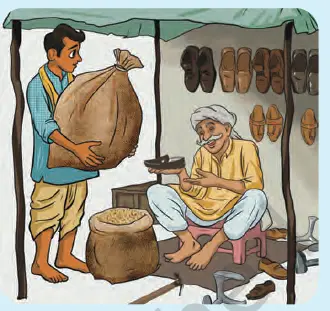
Extra Important Question Answers Chapter 11 From Barter to Money Class 7 Subject Social Science
In Text:
- How did exchange take place before money?
Answer:
- People exchanged goods or services directly.
- This system was called the barter system.
- It required both parties to want what the other had.
- Items like cattle, cloth, grains, and salt were used.
- No fixed value system existed in such exchanges.
- Why did money come into existence?
Answer:
- Barter had many limitations like lack of common value.
- Difficult to carry or divide large goods.
- Required double coincidence of wants.
- Could not store perishable goods easily.
- Money solved these problems by becoming a common medium of exchange.
- How has money transformed into various forms over time?
Answer:
- Started with barter using goods like salt and cattle.
- Moved to using cowrie shells as symbolic currency.
- Then came metal coins made from copper, silver, and gold.
- Later, paper currency replaced coins for easier handling.
- Today, digital money like UPI, cards, and net banking is widely used.
More Questions:
- Why Do we Need Money?
Answer:
- To overcome barter difficulties.
- Acts as a standard measure of value.
- Easy to store and transport.
- Enables deferred payment (buy now, pay later).
- Used in all kinds of transactions for goods and services.
- What are the different types of difficulties you encountered in the situation above?
Answer:
- Finding someone who needs exactly what you have.
- Deciding how much of your item is worth in exchange.
- Carrying bulky items like ox or wheat (portability).
- Unable to divide certain goods (divisibility).
- Difficulty storing goods like grain (durability).
- What are the different ways in which money would make the above situation easier for the farmer?
Answer:
- Farmer could sell the ox for money once.
- Use money to buy different things at different times.
- No need to find people who want exactly what he has.
- Easy to carry and store money compared to goods.
- Money can be used for exact value matching.
More:
- The illustrations above show you some of the ways in which people practise barter today. Have you observed similar practices in your locality? What are the types of experiences people have in this process?
Answer:
- Yes, old clothes are sometimes exchanged for utensils.
- Farmers may trade vegetables for other goods in rural areas.
- Community fairs may have barter stalls (like Junbeel Mela).
- Book exchanges in schools or clubs are common.
- These practices create a sense of sharing and reduce waste.
- Suppose you need to buy a book. You have ₹50 in your pocket. You visit the bookshop in your neighbourhood where the shopkeeper tells you that the book is worth ₹100. What options do you have to buy the book today? Will you request the shopkeeper to allow you to make the rest of the payment later?
Answer:
- Ask the shopkeeper for deferred payment — pay balance later.
- Borrow ₹50 from someone and return it later.
- Use a digital payment app to complete the purchase.
- Save ₹50 and come back with full amount next time.
- This shows money allows flexibility in transactions.
- Look at the timeline given below. What are the changes in money that you observe?
Answer:
- 6000 BCE: Barter system using goods.
- 1000 BCE: Use of cowrie shells.
- 600 BCE: Introduction of metal coins.
- 1861: Official paper money began in India.
- 2016 onwards: Digital money like UPI and cards became common.
Additional:
- The coins shown in Fig. 11.12 were found during excavations in Pudukkottai in Tamil Nadu. Their heads embossed are those of Roman kings. What conclusions can we draw from such a finding?
Answer:
- Shows active trade between India and Rome.
- Roman traders came to Tamil Nadu for goods like spices and pearls.
- Indian kingdoms accepted Roman coins, proving foreign exchange systems.
- Indicates India’s strong maritime trade links in ancient times.
- Coins serve as archaeological evidence of global economic contact.
- What do you think happened as coins began to be used for all types of exchanges, whether to buy vegetables or to buy some land? What problems could have come up?
Answer:
- Carrying large amounts of coins was inconvenient and heavy.
- Difficult to store safely in large quantities.
- Increased chances of theft or loss.
- Small denominations required too many coins for bigger purchases.
- These problems led to the invention of paper money.
To Learn More In Text Questions Click Below:
Chapter 3- Climates of India
Chapter 4- New Beginnings: Cities and States
Chapter 5-The Rise of Empires
Chapter 6- The Age of Reorganisation
Chapter 7- The Gupta Era: An Age of Tireless Creativity
Chapter 8- How the Land Becomes Sacred
Chapter 9 –From the Rulers to the Ruled: Types of Governments
**************************************
MCQs:
Chapter 1- Geographical Diversity of India
Chapter 2- Understanding the Weather
Chapter 3- Climates of India
Chapter 4- New Beginnings: Cities and States
Chapter 5- The Rise of Empires
Chapter 6- The Age of Reorganisation
Chapter 7 – The Gupta Era: An Age of Tireless Creativity
Chapter 8- How the Land Becomes Sacred
Chapter 9 –From the Rulers to the Ruled: Types of Governments
**************************************
NCERT Solutions:
Chapter 1- Geographical Diversity of India
Chapter 2- Understanding the Weather
Chapter 3- Climates of India
Chapter 4- New Beginnings: Cities and States
Chapter 5–The Rise of Empires
Chapter 6- The Age of Reorganisation
Chapter 7 – The Gupta Era: An Age of Tireless Creativity
Chapter 8- How the Land Becomes Sacred
Chapter 9 –From the Rulers to the Ruled: Types of Governments